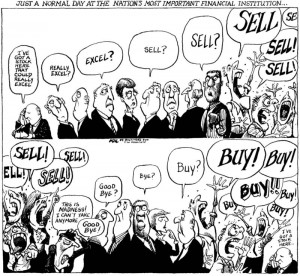 Šiomis mintimis norisi pasidalinti po mūsų straipsnio „Suderintas agentų ir stochastinis finansų rinkų modelis“ paskelbimo laisvos prieigos tarpdisciplininiame mokslo žurnale PLoS ONE [1]. Tai daugelio metų pastangų, įgyvendinamų VU Teorinės fizikos ir astronomijos institute, plėtoti ekonofizikos tyrimus ir Lietuvoje rezultatas. Nors atlikti darbai daugiausiai siejami su akcijų kainų svyravimų biržose statistikos modeliavimu, panaudojant statistinės fizikos metodus, jų idėjinis pagrindimas ir gaunamų rezultatų apibendrinimas aprėpia daug platesnes socialinių ir fizinių mokslų ribas. Noras praplėsti nusistovėjusias ribas ir pasiekti daugiau savitarpio supratimo tarp dirbančių fizinių ir socialinių mokslų metodais yra mūsų pagrindinė motyvacija užsiimti ekonofizika.
Šiomis mintimis norisi pasidalinti po mūsų straipsnio „Suderintas agentų ir stochastinis finansų rinkų modelis“ paskelbimo laisvos prieigos tarpdisciplininiame mokslo žurnale PLoS ONE [1]. Tai daugelio metų pastangų, įgyvendinamų VU Teorinės fizikos ir astronomijos institute, plėtoti ekonofizikos tyrimus ir Lietuvoje rezultatas. Nors atlikti darbai daugiausiai siejami su akcijų kainų svyravimų biržose statistikos modeliavimu, panaudojant statistinės fizikos metodus, jų idėjinis pagrindimas ir gaunamų rezultatų apibendrinimas aprėpia daug platesnes socialinių ir fizinių mokslų ribas. Noras praplėsti nusistovėjusias ribas ir pasiekti daugiau savitarpio supratimo tarp dirbančių fizinių ir socialinių mokslų metodais yra mūsų pagrindinė motyvacija užsiimti ekonofizika.
Kaina ekonomikoje vaidina esminį vaidmenį, nes tik jos pagalba praktinėje ir teorinėje ekonomikoje atsiranda kiekybinis aprašymas pinigine išraiška. Tarp visų kainos apibrėžimo galimybių rinkos kaina užima ypatingą vietą, nes ji yra artimiausia visiems realioje ekonomikoje vykdomiems prekių ir paslaugų mainams. Todėl tikėjimas rinkos kainos objektyvumu yra vyraujančios ekonomikos teorijos pagrindas, grindžiamas racionalių lūkesčių ir efektyvios rinkos sąvokomis. Šiomis koncepcijomis vadovaujasi didžiulė finansinių rinkų (akcijos, kiti vertybiniai popieriai, išvestiniai finansiniai instrumentai, valiutų mainai ir t.t.) industrija, neišvengiamai lemianti ir visos globalios ekonomikos sveikatą. Tačiau nuolat pasikartojančios globalios ekonominės krizės stiprina vyraujančios ekonomikos teorijos kritikų gretas.
I solve this problem directly.
You write:
“The observed fluctuations of the market price are larger than it should be according to the equilibrium view of the efficient market theory.”
I know. I did not in 1999 when I published Axiomatic Theory of Economics, but now I and everybody else is aware of this. This awareness has resulted in some rather outlandish explanations; only yesterday I addressed a man who was trying to overlay a bunch of normal distributions to form something resembling an inverse power law distribution. Ad hoc!
You write:
“The understanding that unstable financial and economic processes have to be considered on the bases of statistical physics is taking place.”
Why statistics? Why not just solve the problem directly? I studied physics in college and I am sure that I remember every problem being solved directly through logical deduction based on the axioms of Newton or, in the event of relativistic speeds, the additional axioms of Einstein. The use of statistics in physics I do not remember. But I do remember being sharply rebuked by my statistics professor when my (initial) proposal for a research project turned out to be of phenomena whose deterministic explanation was well known – just not by me. Oops! I think the same thing is happening with you guys.
You write:
“From our point of view the proposed model suggests new interpretation of market price, which may exhibit very large deviations from fundamental value. In this new interpretation market price highlights herding based drifts of agent-based societies, neglecting intrinsic (fundamental) understanding of value and surrendering to the imitational waves of collective wandering. Such wandering can be supported by the public tales about unexpected economic opportunities, emerging in the context of new financial, technological, social and political tendencies.”
To neglect an understanding of value and surrender to imitational waves of collective wandering (supported by “public tales,” no less) is to build your house on sand. Be faithful to the fundamentals! (I mean the fundamentals of axiomatic economics; those of neoclassical economics have never worked.)
With only one additional assumption, so reasonable that it could almost go unsaid (though this being an axiomatic theory, all assumptions are said explicitly), I prove the inverse power law distribution directly without having to assume that people are antelope, dashing from one observed price to the next, their behavior in between being just mad galloping along with the herd.